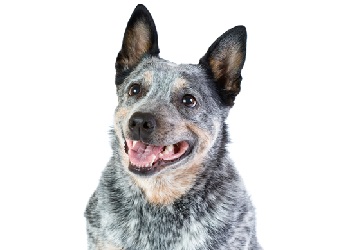 The origins of the Australian Cattle Dog’s is debated greatly with stories of its development in both NSW and Queensland. They have been called Hall’s Heelers, Queensland Blue Heelers and Blueys.
The origins of the Australian Cattle Dog’s is debated greatly with stories of its development in both NSW and Queensland. They have been called Hall’s Heelers, Queensland Blue Heelers and Blueys.
In the 19th century, a NSW cattle farmer Thomas Hall crossed the herding dogs used in Northumberland with Australian dingoes, resulting in dogs known as ‘Hall’s Heelers’. From this developed the Australian Cattle Dog that became often called the red or blue heeler. Later on, another Queensland landowner George Elliot experimented with the crossing of the Dingo and Collie.
Today, Australian Cattle Dogs still play a vital role as working dogs and also live as family pets, participating in a range of activities from the show ring to sporting events.
Watchful, spirited and eager to please, American Staffordshire Terriers make great family pets.
Personality
Friendly, active and hard working best describes this breed. Cattle dogs are highly intelligent, agile and very energetic, requiring training from an early age. They are a loyal dog which loves human company. They do best in a secure, large outside area to run and play ball in, but can also make a good indoor pet.
The Cattle Dog is excellent at agility and enjoys all sorts of training to keep its mind active and stimulated. It loves the company of another dog and needs plenty of daily exercise. A supply of toys is a good idea – they love to chase Frisbee’s – and remember not to leave your washing on a line that a Cattle Dog can reach.
Australian Cattle Dogs are protective, brave and alert, making excellent watchdogs. They are also easy to train because of their high intelligence.
Upkeep
This is a ‘set and forget’ pet as far as grooming is concerned, requiring an occasional brushing. But because Australian Cattle Dogs are very heavy shedders, you may find a daily brush is necessary to remove loose hair.
These dogs have high energy levels so a long, daily walk is absolutely essential.
Like all dogs, Australian Cattle Dogs require regular tick, flea, intestinal worms and heartworm treatments. Consult your veterinarian on treatment options. Desexing and vaccination against diseases, such as the deadly parvo virus and highly infectious canine cough, are also important to discuss with your vet.
Compatibility
Cattle Dogs respond very well to training and they love to learn. Challenging, interesting training is best and the breed is quick to learn tricks in return for food or play rewards.
Usually obedient, happy, affectionate and playful dogs, Australian Cattle Dogs love to be your constant companion and go everywhere with you. They are not naturally an aggressive breed but can be very protective and, as they were bred for their biting ability, take caution when strangers approach. Running and squealing children could also possibly get their heels nipped.
Harsh treatment of this breed will easily produce aggression as with all dogs, but because the Cattle Dog has been specifically bred for its ability to nip, it is especially important to use only humane training methods and to socialize a puppy early. Begin socialization early by visiting parks and other recreation areas to expose them to a variety of people and animals.
In return you will have a safe, faithful, loyal companion who loves your company, loves to ride in the car, chase a ball and to swim or run all day with you.
Australian Cattle Dogs are not suitable for apartment life and do best with a large yard.
Fact file
Breed classification Working dog
Size Medium
Origin Australia
Lifespan 10-12 years
Colors Red and blue
Cost $650 – $1000
Common hereditary problems Deafness, blindness, arthritis, elbow dysplasia and cruciate ligament problems.
